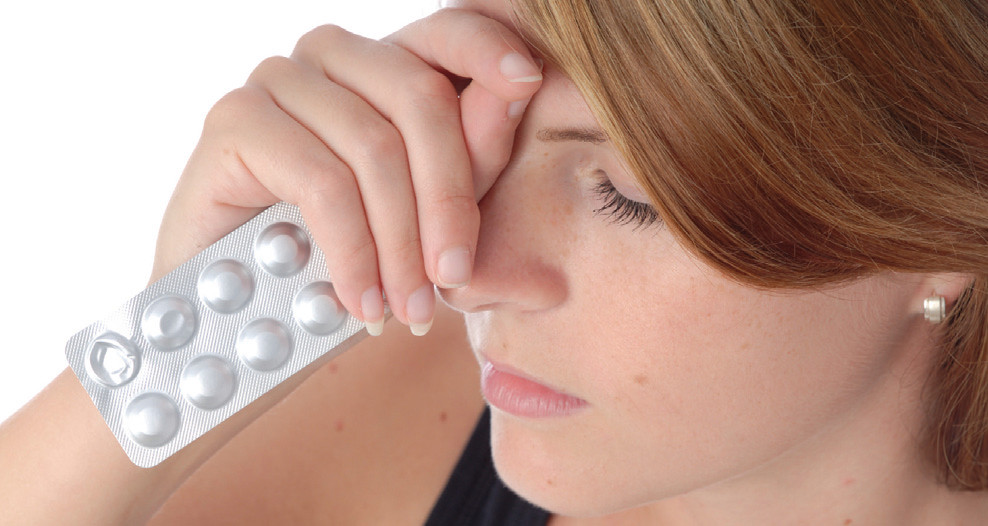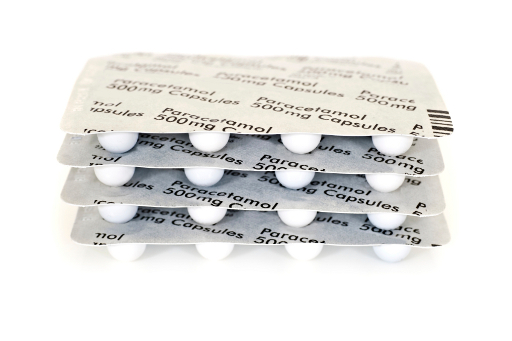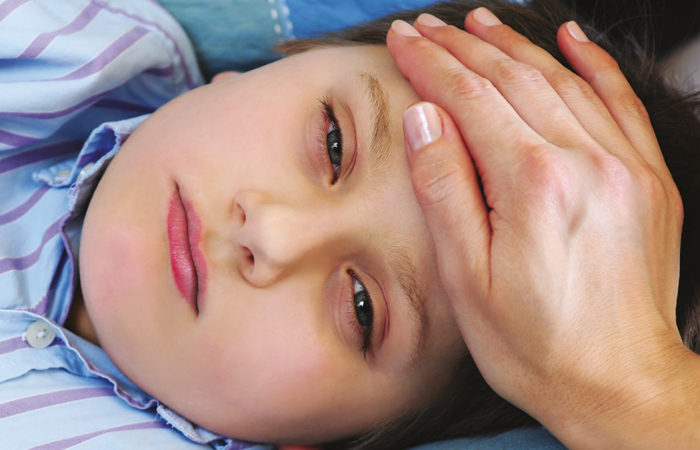Headache & migraine: Knock it on the head
In Clinical
Follow this topic
Bookmark
Record learning outcomes
Migraine can blight the lives of those affected but there is plenty pharmacists can do to halt or lessen the impact on patients.

Learning objectives
After reading this feature you should be able to:
- Identify the symptoms of migraine
- Recommend the most appropriate treatments and lifestyle advice for people affected by migraine
- Understand the impact of migraine on women, children and adolescents.
Migraine is a common but complex and often frightening neurological condition that affects one in seven people in the UK.
€Frequently, patients have had poor or minimal advice on how to prevent migraine or manage acute attacks effectively,€ says Dr Catherine Munro, headache specialist at the National Migraine Centre. €It has a massive impact on the lives of sufferers and if badly managed can lead to depression, anxiety, job loss, poor school attendance and other problems.€
Migraine is a common health condition, affecting around one in five women and one in 15 men. The condition usually begins in early adulthood but can also start in children as young as three years of age. People affected by migraine experience an average of 13 attacks each year.
The symptoms vary from one person to another but are usually a moderate or severe headache felt as a throbbing pain on one side of the head. Many people also experience nausea, vomiting and increased sensitivity to light or sound. Attacks usually last between four and 72 hours.
The commonest types of migraine fall into two categories: migraine with aura and migraine without aura. Not everyone will have a 'typical' migraine. Symptoms of aura, which affect about one in three people with migraines, include:
€¢ Visual problems (e.g. seeing flashing lights, zig-zag patterns or blind spots)
€¢ Numbness or a tingling sensation, which usually starts in one hand and moves up the arm before affecting the face, lips and tongue
€¢ Feeling dizzy or off balance
€¢ Difficulty speaking
€¢ Loss of consciousness, although this is unusual.
Sarina Mughal, professional services pharmacist at the Day Lewis Pharmacy group, says it is important to go through a standard set of protocol questions to ascertain exactly what sufferers' history and symptoms are, because people may say they are having a migraine attack when it could simply be a severe headache. €In terms of pain management, it is important to be able to differentiate the symptoms of migraine, cluster headache, frontal headache and tension headache,€ she says.
The exact cause of migraines is unknown, although they are thought to be the result of temporary changes in the chemicals, nerves and blood vessels in the brain. Most people who experience migraines are genetically predisposed to them. Some sufferers find their migraines are caused by certain triggers, which commonly include stress, lack of food, certain foods and alcohol, hormonal changes in women, lack of sleep and the environment. Keeping a diary could help sufferers to identify possible causes of their migraines.
Pharmacological approaches
British Association for the Study of Headache (BASH) guidelines say a cure is not a realistic aim when treating migraine and patients need to understand this.1
There is evidence that many people affected by migraine have low expectations of what is achievable through optimum management and in the past the attitudes of healthcare professionals have reinforced this. €The shared objective should be control of symptoms so that the effect of the illness on a patient's life and lifestyle is the least it can be,€ says BASH.
The guidelines recommend that patients should work through the treatment options in a rational order, and continue to do so until they have found what suits them best.
Drug treatment review
Aspirin
Relieves pain and reduces inflammation but is unsuitable for people with asthma and children under 16 years of age. It can damage the lining of the stomach and should not be given to people with stomach ulcers.
Catherine Munro says simple analgesics can be very helpful if taken early in a migraine attack but often patients are unaware of how to take them effectively. If the patient is suffering from nausea, soluble aspirin can be helpful, especially if taken in a sugary fizzy drink, perhaps with some caffeine, at the onset of a migraine attack.
Ibuprofen
Ibuprofen relieves pain and reduces inflammation and is less likely to cause stomach irritation but is not recommended for people with high blood pressure, asthma, kidney problems or stomach ulcers. It should be taken with food. Dr Munro says ibuprofen can be taken in high doses at the onset of a migraine and rapid release forms may be useful.
Patients need the usual guidance about preventing indigestion. Omeprazole may be needed with aspirin or ibuprofen long-term.

Paracetamol
Paracetamol reduces pain and has few side-effects when taken at the recommended dosage. It should not be taken by anyone with kidney or liver problems.
Codeine
Codeine or medicines containing codeine, such as co-codamol, are not recommended. They can cause constipation, be addictive, make nausea worse and result in rebound headaches.
Sumatriptan
Triptans work by interfering with the brain chemical 5HT. Unlike painkillers, a triptan should not be taken too early in a migraine attack. The first dose should be taken when the headache is just beginning to develop, but not before this stage.
€Sumatriptan can be very helpful,€ says Dr Munro, €but patients should not take it on too many days or repeat the dose on day one [if no response]. If using it frequently €“ more than six days a month €“ they should be referred back to a doctor.€ Up to half of people who take triptans find their migraine comes back within two days.
Antiemetics
Analgesics can be taken with a prokinetic antiemetic such as domperidone or metoclopramide. Gastric stasis occurs while a migraine is developing, leading to nausea and vomiting in some sufferers, but also leading to inefficient and slow absorption of medications. This slow absorption means the migraine has time to gather momentum and any analgesics may seem ineffective. An antiemetic, even when nausea and vomiting are not troublesome, can be extremely helpful.
Key facts
- Migraine is a common condition which affects three times as many women as men
- Prompt pharmacological treatment and avoidance of triggers can help to control and prevent migraine attacks
- Parents of children and adolescents affected by headaches and migraine need advice and reassurance about effective treatment
Useful advice
Sarina Mughal of Day Lewis says it is important that all members of the pharmacy team are trained to provide advice on migraine treatment. Information cards produced by pharmaceutical companies, which break down the different treatments into a flowchart, can be useful aide memoires, she says.
Patients should be given clear instructions about taking their preferred painkiller in effective doses as early as possible after symptoms begin. Many migraine sufferers do not take a painkiller until the migraine is established, which means it is often too late for the painkiller to work well. It should also be explained that the maximum allowed daily dose of painkiller should be taken within 24 hours.
Patients should be advised that using any painkillers too frequently may cause medication overuse headache, so they should be made aware of the upper use limits of OTC medications €“ 14 days per month for simple analgesics; six days for triptans. Further advice about medications should be given to those planning a pregnancy.
Possible breakthrough in migraine therapy?
To date, the treatment for migraine has been with drugs that are actually used for other conditions but have accidentally been found to be helpful for migraine, says Dr Fayyaz Ahmed, consultant neurologist at Hull and East Yorkshire Hospitals NHS Trust and a trustee of the Migraine Trust.
A breakthrough is expected in the next 18-24 months, he says, with the development of a drug based on calcitonin gene-related peptid (CGRP) antagonists and monoclonal antibodies against the CGRP receptor in migraine. €CGRP is a chemical strongly linked with migraine and a drug working against this would be the first ever [specific] anti-migraine drug that would actually work for migraine patients, with a very good side-effect profile. The first drug might hit the market sometime next year.€
Impact of migraine on women
Migraine affects three times as many women as men and it has long been recognised that there is a close relationship between the female sex hormones and migraine.
Some women are more affected by migraines just before their period starts when oestrogen levels fall. Women experiencing the onset of the menopause may also find their migraine attacks are linked to their periods during the peri-menopause. The ovaries produce less oestrogen and changes in their hormone levels can lead to migraine attacks being more severe or frequent.
According to the Migraine Trust, the few studies that have been conducted in this area suggest that the menopause makes migraine worse for up to 45 per cent of women.
During the menopause the irregularity of a woman's periods can make it harder to cope with migraines as they may be more difficult to predict. In addition, the symptoms of the menopause (e.g. hot flushes, night sweats and disturbed sleep) can add to stress levels, further increasing the likelihood of experiencing a migraine.
A number of studies have identified a small risk of stroke in younger women with migraine, especially migraine with aura, but the British Heart Foundation says this isn't necessarily a cause for alarm as the overall risk is low.
People affected by migraine experience an average of 13 attacks each year
Increased risk of heart disease?
There is also some evidence of a link between migraine and cardiovascular disease. A recent study of 115,541 women, aged 25-42 years, who were followed for more than 20 years, reported a 50 per cent increased risk of cardiovascular disease, including mortality.2
Maureen Talbot, senior cardiac nurse at the British Heart Foundation, says the number of women with migraines who died of heart problems during the study represented less than 0.2 per cent and that, while migraine may have increased their risk, the overall risk remained small.
Contraceptive pill
The risk of having an ischaemic stroke is increased by use of the combined contraceptive pill, so women who experience migraine with aura should be advised not to use the combined pill.
Women who have migraine without aura can usually take the combined contraceptive pill safely, unless they have other stroke risk factors, such as high blood pressure or a family history of cardiovascular disease.
Sarina Mughal, of Day Lewis, says pharmacies should encourage patients to see them as the first port of call for migraine advice and treatment. €This is an area in which pharmacy teams can give patients good advice and plenty of time to talk through all the issues that they might be concerned about,€ she says.
Managing headache and migraine in children and adolescents3

Childhood headache is common and children may suffer headache as often and as severely as adults. Around 8 per cent of children have migraines and 1 to 2 per cent of adolescents experience a headache on more than 15 days per month for at least three months.
Headaches and migraine result in children and adolescents having to take days off from school and missing out on social and sporting activities. The pain affects their mood, schoolwork, quality of life and can damage their self-confidence and relationships with friends.
Surveys have shown that nearly three-quarters of parents are likely to turn to pharmacists and pharmacy staff for advice when purchasing headache medication, but few pharmacy staff report speaking about headache in children with parents.
€Effective management of headache and migraine in children and adolescents in the pharmacy can reduce the burden on GPs and build further confidence in parents and carers that pharmacy can be their first port of call for healthcare advice,€ says pharmacist Christine Glover.
Some parents can be risk averse with medicines and may be prone to delaying or withholding dosing or using a lower dose than recommended. While it is important to recognise 'red flags', childhood headache is rarely sinister (less than one in 1,000 children with chronic headache as the only symptom are likely to have a brain tumour, for instance) and the condition can be well managed by parents/carers at home with help from pharmacy teams.
Pharmacological treatments
Dr Ishaq Abu-Arafeh, consultant paediatrician and chairman of the Child and Adolescent Committee of the International Headache Society, says it is important to reassure parents regarding the efficacy and safety of painkillers when given in the right dose, at the right time intervals and in the right formulation.
Pharmacists should advise parents to:
€¢ Treat as soon as possible after the onset of headache as this will achieve a better response, avoids the emergence of nausea and vomiting, and ensures better absorption of medicine before gastric stasis
€¢ Give the highest recommended dose when treatment is initiated
€¢ Repeat the dose if pain persists at regular intervals (six hours for paracetamol; eight hours for ibuprofen)
€¢ Seek further advice if pain continues beyond three days.
Non-pharmacological options
In addition to offering analgesics, the following steps may also be helpful during a headache:
€¢ Avoid aggravating factors such as light and noise
€¢ Apply a cool, moist cloth to the forehead
€¢ Get the child to rest and try to sleep.
General advice regarding the prevention of headache should include encouraging children to have regular meals, regular sleep, regular exercise and rest, a regular intake of water and to avoid excessive caffeine-containing drinks. A headache diary can help to establish patterns and identify trigger factors.
References
1. Guidelines for all healthcare professionals on the diagnosis and management of migraine, tension-type headache, cluster-type headache, medication-overuse headache. BASH. 2010 bash.org.uk/wp-content/uploads/2012/07/10102-BASH-Guidelines-update-2_v5-1-indd.pdf
2. BMJ 2016; 353:i2610 bmj.com/content/353/bmj.i2610
3. Report of an education meeting held in July 2016 by Reckitt Benckiser
